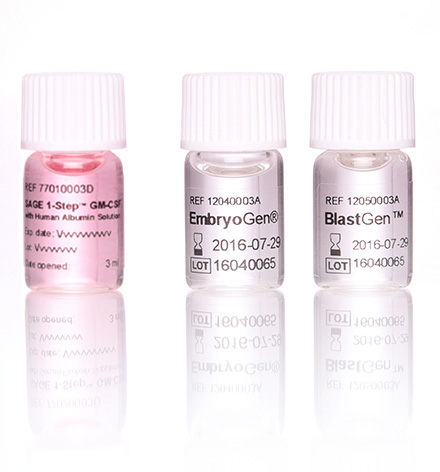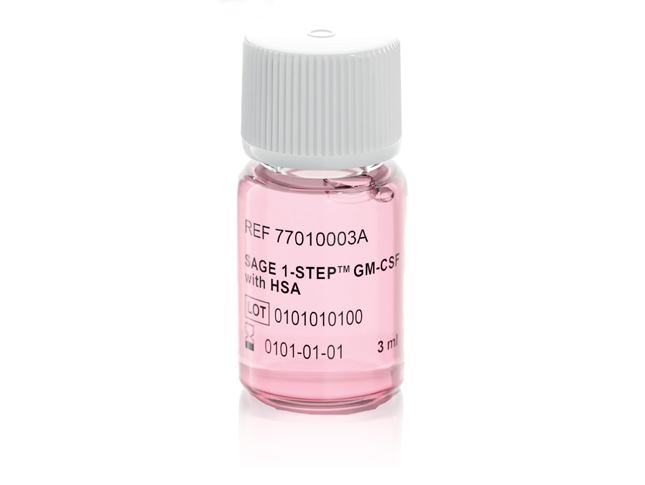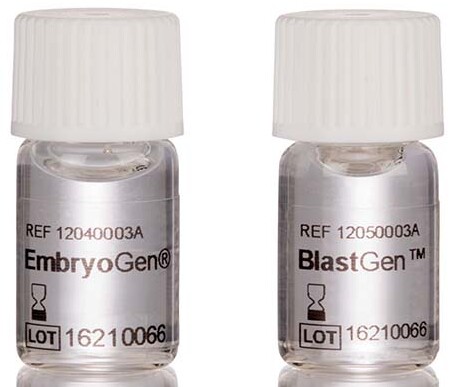Culture Media with GM-CSF
Unique culture media for poor prognosis patients
SAGE® 1-Step™ GM-CSF Culture and Transfer Medium, EmbryoGen® and BlastGen™ and make up the first culture media suite containing the recombinant human cytokine Granulocyte-Macrophage Colony-Stimulating Factor (GM-CSF)
• Embryo−endometrial communication is key to successful pregnancy
• Cytokines play a critical role in driving this communication
• Culture media supplemented the GM-CSF has a positive effect on implantation and pregnancy rates
• Our innovative culture media suite offers GM-CSF solutions for both continuous and sequential embryo culture protocols.
Availability
Available in selected countries worldwide.

Key Product Information
Bring new hope to your patients
with our GM-CSF media solutions
SAGE 1-Step™ GM-CSF culture and transfer medium, EmbryoGen and BlastGen make up our novel culture media suite supplemented with the recombinant human cytokine GM-CSF. The inclusion of cytokines aims to reduce embryonic stress by creating a more physiological in vitro environment, increasing the chance of a successful implantation1.
This innovative media suite provides both a single-step and sequential solution, giving you an additional option for your poor prognosis patients without the need to change your existing protocol.
Recommended for patients who have2
- Experienced recurrent clinical and biochemical pregnancy loss
- Experienced recurrent implantation failure
- Unexplained infertility
- Advanced maternal age
CONTINUOUS

SAGE 1-Step GM-CSF
The world’s first single-step culture medium containing the recombinant human cytokine GM-CSF. Click here to learn more about SAGE 1-Step GM-CSF.
SEQUENTIAL

EmbryoGen and BlastGen
The world’s first media suite containing the recombinant human cytokine GM-CSF
Communication is key for a successful pregnancy
Communication between the embryo and endometrium is crucial in creating the right environment for a successful pregnancy.
Compromised embryo competence, impacting the maternal-embryo dialogue, may lead to an increase in implantation failure, preclinical pregnancy loss and miscarriage.
Poor communication between embryo and endometrium may result in as much as:
40%
of unexplained infertility3,4
80%
of unexplained pregnancy losses3,4
increase in ongoing implantation rate with GM-CSF containing media
Cytokines: a critical role in communications
Cytokines drive the dialogue between the embryo and endometrium and are increasingly expressed throughout embryo development5.
The cytokine GM-CSF is a natural signaling molecule that allows for both autocrine and paracrine communication between the embryo and endometrium.
Providing a more physiological in vitro environment
Our innovative culture media suite is supplemented with the cytokine GM-CSF to mimic the environment found
in the female reproductive tract at conception. Creating the best possible in vitro conditions for the embryo, with the use of this cytokine, will promote successful implantation through improved endometrial receptivity.
Fertilization
Day 0-1
Fertilization
For IVF or ICSI, media that supports both gametes during fertilization and promotes sperm function is recommended.
Following fertilization, the embryo immediately begins to communicate with its environment and should be moved to media that better supports the next stage
of its development.
Pre-implantation
Day 1-3
Initial dialogue
Cytokines are critical in the communication between the embryo and the endometrium prior to implantation and are naturally found in the reproductive tract at this stage.
In the laboratory setting, exposure of embryos to GM-CSF has been shown to promote blastocyst formation and alleviate the negative effects of in vitro culture.
Apposition, adhesion & trophoblast invasion
Day 3-6
Ongoing support
Maternal-embryo communication is essential for recognition and implantation of the embryo.
Continuing to culture in media containing GM-CSF supports the embryo’s development right through to the blastocyst stage.
Implantation
From embryo transfer onwards
Sustained dialogue
An environment that supports the dialogue between the embryo and endometrium is crucial for successful implantation, especially for poor prognosis patients. GM-CSF is known to play an important role in this dialogue, as well as the regulation of the maternal immune response.
Transferring embryos in media with GM-CSF ensures that the cytokine is present in the reproductive tract at this vital time.
GM-CSF culture media in the clinical setting
The introduction of a GM-CSF containing culture medium to the IVF world was based on the positive results of EmbryoGen in a prospective randomized clinical trial2, which showed its positive effect on ongoing implantation and live birth rates.
3 days of embryo culture in GM-CSF containing medium improved live birth rate2
Subgroup analysis (n=289 previous miscarriage patients) from a multi-center, randomized, controlled parallel group, double blinded trial with 1,300+ patients from 14 centers.
Data on the clinical use of the full GM-CSF media suite, EmbryoGen and BlastGen, demonstrates that culturing in GM-CSF containing media until the blastocyst stage increases pregnancy and implantation rates6.
EmbryoGen and BlastGen have a positive effect on pregnancy rate and increase the chances of obtaining a live birth6
Blastocyst transfer (frozen-thawed) success rates from a prospective randomized clinical trial with 90 Single Embryo Transfer (SET) cycles using sibling oocytes.
Definitions
Pregnancy rate: Women with positive hCG at week 2 per women with transfer. Implantation rate: Number of sacs at week 7 per transferred embryo. Ongoing implantation rate: Number of sacs with heart beat at week 7 per transferred embryo. Live birth rate:
Live births per transferred embryo.
Order Codes
| Reference | Description | Size | HSA mg/ml | Shelf Life Guarantee* |
|---|---|---|---|---|
| 12062003 | EmbryoGen & BlastGen | 2x 3 ml | 5 mg/mL | Minimum 8 weeks |
| 12040003 | EmbryoGen | 3 ml | 5 mg/mL | Minimum 8 weeks |
| 12050003 | BlastGen | 3 ml | 5 mg/mL | Minimum 8 weeks |
*Minimum time to expiry

 My Clinic is in the United States
My Clinic is in the United States My Clinic is in Canada
My Clinic is in Canada